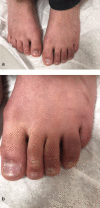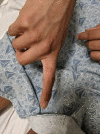Cutaneous Manifestations of SARS-CoV-2 Infection
- PMID: 35247198
- PMCID: PMC8897723
- DOI: 10.1007/s40257-022-00675-2
Cutaneous Manifestations of SARS-CoV-2 Infection
Abstract
Severe acute respiratory syndrome coronavirus 2 (SARS-CoV-2) has caused the coronavirus disease 2019 (COVID-19) pandemic, affecting people worldwide. SARS-CoV-2 infection is a multisystem disease with potential for detrimental effects on various systemic organs. It affects people of all ages with varying degrees of disease severity. Patients with SARS-CoV-2 infection commonly present with dry cough, fever, and fatigue. A clinical spectrum of skin findings secondary to SARS-CoV-2 has also been reported. The most common cutaneous patterns associated with COVID-19 are chilblain-like lesions (CBLL), maculopapular lesions, urticarial lesions, vesicular lesions, and livedoid lesions. Other skin findings secondary to SARS-COV-2 infection are erythema multiforme (EM)-like lesions and skin findings associated with multisystem inflammatory syndrome in children (MIS-C) and rarely multisystem inflammatory syndrome in adults (MIS-A). Physician awareness of skin manifestations of SARS-CoV-2 infection can help with early identification and treatment. This narrative review provides an update of various skin manifestations reported with SARS-CoV-2 infection, including clinical presentation, proposed pathogenesis, histopathology, prognosis, and treatment options.
© 2022. The Author(s), under exclusive licence to Springer Nature Switzerland AG.
Conflict of interest statement
Dr Huang serves on the Scientific Advisory Board for EllaOla. The remaining authors have no conflicts of interest.
Figures
Similar articles
-
Covid-19 skin manifestations: an update.Curr Opin Pediatr. 2021 Aug 1;33(4):380-386. doi: 10.1097/MOP.0000000000001036. Curr Opin Pediatr. 2021. PMID: 34127574 Review.
-
COVID-19 and cutaneous manifestations: A review of the published literature.J Cosmet Dermatol. 2023 Jan;22(1):4-10. doi: 10.1111/jocd.15477. Epub 2022 Nov 7. J Cosmet Dermatol. 2023. PMID: 36342945 Free PMC article. Review.
-
Cutaneous Manifestations of COVID-19: A Systematic Review.Adv Wound Care (New Rochelle). 2021 Feb;10(2):51-80. doi: 10.1089/wound.2020.1309. Epub 2020 Oct 19. Adv Wound Care (New Rochelle). 2021. PMID: 33035150 Free PMC article.
-
Cutaneous Manifestations in the Context of SARS-CoV-2 Infection (COVID-19).Actas Dermosifiliogr (Engl Ed). 2020 Nov;111(9):734-742. doi: 10.1016/j.ad.2020.08.002. Epub 2020 Aug 31. Actas Dermosifiliogr (Engl Ed). 2020. PMID: 32882184 Free PMC article. Review. English, Spanish.
-
Top 10 acral skin manifestations associated with COVID-19: A scoping review.Dermatol Ther. 2021 Nov;34(6):e15157. doi: 10.1111/dth.15157. Epub 2021 Oct 21. Dermatol Ther. 2021. PMID: 34628708 Free PMC article.
Cited by
-
A Young Adult With Multisystem Inflammatory Syndrome Following Weeks of Initial COVID-19 Respiratory Infection, With No Prior COVID-19 Vaccination: A Case Report.Cureus. 2023 Jun 21;15(6):e40745. doi: 10.7759/cureus.40745. eCollection 2023 Jun. Cureus. 2023. PMID: 37485227 Free PMC article.
-
Factors influencing the outcomes of dermatoses during the COVID-19 outbreak in China: a retrospective study.Front Med (Lausanne). 2024 May 30;11:1417358. doi: 10.3389/fmed.2024.1417358. eCollection 2024. Front Med (Lausanne). 2024. PMID: 38873214 Free PMC article.
-
Teledermatology for Common Inflammatory Skin Conditions: The Medicine of the Future?Life (Basel). 2023 Apr 18;13(4):1037. doi: 10.3390/life13041037. Life (Basel). 2023. PMID: 37109566 Free PMC article. Review.
-
Acrocyanosis: The Least Known Acrosyndrome Revisited With a Dermatologic Perspective.Dermatol Res Pract. 2025 Jan 16;2025:2904301. doi: 10.1155/drp/2904301. eCollection 2025. Dermatol Res Pract. 2025. PMID: 39850714 Free PMC article. Review.
-
Cyanotic Fingers and Omicron, Oh My!Indian J Dermatol. 2023 Mar-Apr;68(2):231-232. doi: 10.4103/ijd.ijd_567_22. Indian J Dermatol. 2023. PMID: 37275814 Free PMC article. No abstract available.
References
Publication types
MeSH terms
Supplementary concepts
LinkOut - more resources
Full Text Sources
Medical
Miscellaneous




